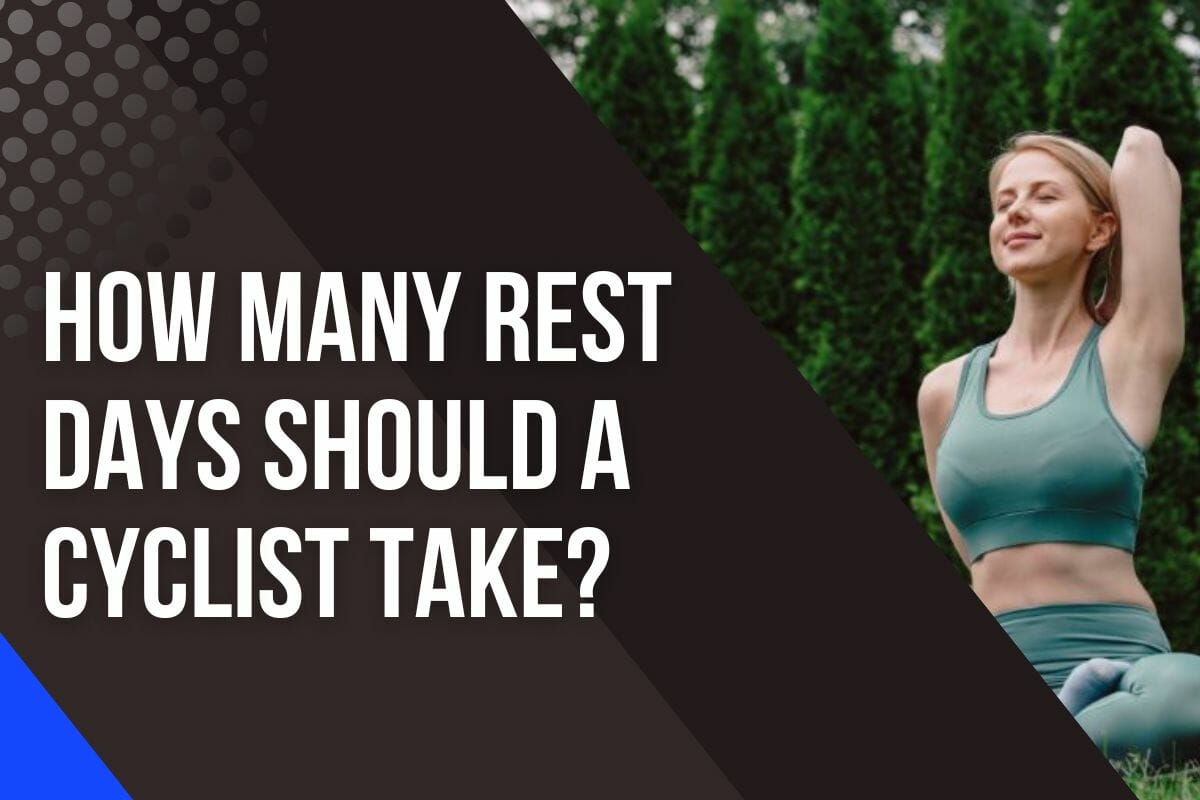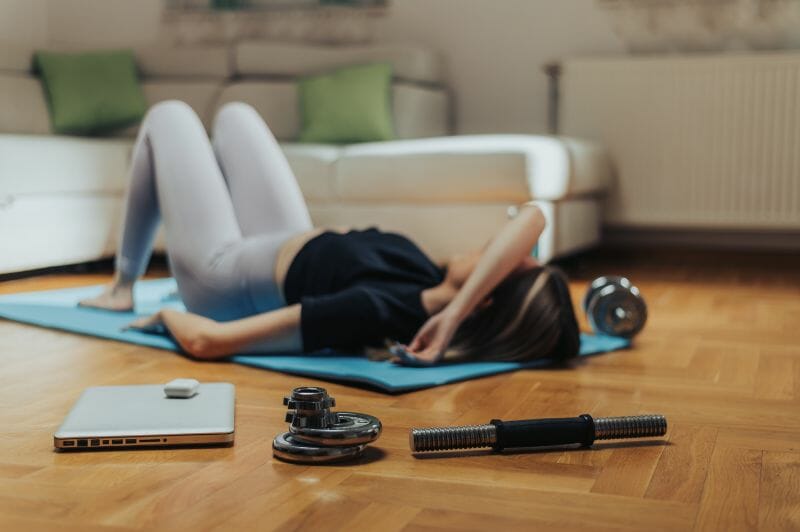How Many Rest Days Should A Cyclist Take Each Week?

Are you a cyclist looking to maximize the results of your training?
Rest is essential for any athlete, and cycling is no exception. But knowing how many rest days to take can be confusing.
It’s important to strike a balance between getting enough rest and keeping up with your fitness goals.
Generally speaking, most cyclists should take at least 1 to 2 days off from cycling each week in order to avoid overtraining and fatigue.
In this article, we’ll dive into all the details of cycling and rest days, including what they are, how much rest you need when to take them, and more!
What Is A Rest Day?
As an avid cyclist, I understand the importance of rest days for my performance and overall health.
Taking a rest day is about more than just taking a break from intense exercise.
It’s about giving your body time to repair itself and recover from any inflammation or fatigue that has built up during training.
Rest days are also important for maintaining a proper heart rate and getting enough sleep to ensure you have the energy you need for the next day’s ride.
For me, this usually means a combination of active recovery (light activity such as stretching or yoga) and complete rest (no activity at all).
Although there is no one-size-fits-all answer when it comes to how many rest days you should take per week, it’s important to listen to your body and adjust accordingly so that you can reap the benefits while avoiding injury.
Sleep And Recovery
Now that we’ve discussed what a rest day is and why it’s necessary, let’s talk about sleep.
Sleep plays an integral role in recovery and should not be overlooked or sacrificed when you’re training.
Quality sleep not only enhances your performance but also reduces the risk of injury or illness due to overtraining.
As a cyclist, getting enough restful sleep is essential for optimal recovery, energy levels, and overall health.

It has been proven that when adults get less than six hours of sleep each night, it can impair their ability to think clearly, affect their mood, and decrease how well the body functions such as appetite regulation or immunity. (1)
Most people should aim for eight hours of quality sleep per night in order to gain the most benefit from their rest days.
Athletes are particularly affected by sleep deprivation and poor-quality rest.
Not getting enough sleep can lead to slower recovery times and injury risks due to weakened muscles and weakened immune systems caused by fatigue.
Research has shown that athletic abilities improved by having quality sleep.
Therefore, it is important for athletes to set aside adequate time for rest to ensure maximum recovery before participating in intense physical activities again.
Rest Vs. Active Recovery
Rest days provide an opportunity for cyclists to actively participate in recovery activities such as stretching and foam rolling.
These activities can help decrease muscle soreness and improve overall performance.
When it comes to rest and recovery, I’m a firm believer in the power of both active and passive methods.
On days when I need to take a break from intense exercise, I make sure to include some light activities such as walking, swimming, or yoga into my routine.
Active recovery helps keep muscles loose while still getting some benefits from cycling without pushing your body to its limits.
The combination of rest days and active recovery days gives cyclists the best of both worlds: allowing them to focus on healing while also maintaining physical fitness levels.
Active Recovery Rides
After a period of intense training and racing, you should take the time to rest and recover.
With that said, it doesn’t mean you have to stay off your bike entirely.
Active recovery rides are also an important part of any cyclist’s routine.
This low-intensity, short-duration rides offer riders many benefits such as increased metabolic efficiency and improved muscular repair.
Research shows that the benefits depend on the intensity level of the active recovery workout.
In general, active recovery rides involve pedaling at a lower intensity than normal rides and at a heart rate of less than 68% of the threshold heart rate.
At this effort level, cyclists are encouraged to use just enough force on the pedals to get them turning while not placing too much strain on their muscles.
This type of riding is beneficial; since it prevents fatigue build-up due to the light demands placed on the legs.
Additionally, active recovery rides are often used as a way for athletes to finish off or “cool down” a training session.

After finishing a hard workout or race, using active recovery will help flush out fatigue-causing metabolites from your muscles quickly and efficiently.
Athletes have found that taking advantage of these post-workout rest periods helps them bounce back quickly from hard efforts.
Putting in good quality miles over time without feeling burned out or overwhelmed.
Ultimately, including active recovery into your weekly routine can help keep you healthy and limit physical stress levels for the long haul when done properly!
How Much Rest Does A Cyclist Need?
The amount of rest a cyclist needs depends on their activity level, fitness goals, and individual preferences.
According to Cycling Weekly Magazine, most cyclists should take at least 2 days off from cycling each week in order to avoid overtraining and fatigue.
This could mean a complete break from riding (or active rest) or low-intensity rides in order to allow the body to properly recover from strenuous activity.
This gives the body time to recover between rides while also allowing for some much-needed mental downtime.
Professional cyclists tend to take extended periods of rest after a race season ends for anywhere from two to four weeks.

During this time off, they must make sure not to overdo it and should replace harder workouts with activities such as yoga or swimming which help the muscles recover without taxing them further.
Incorporating rest into your cycling routine doesn’t mean giving up altogether; rather it means listening closely to your body’s cues about how much recovery time it needs before getting back out there again.
Plan Your Recovery Week
As a cyclist, you know that rest days are essential for optimal performance.
A recovery week is an important part of your training plan and should be incorporated into every periodized training program.
If you’re undertaking an extended period of strenuous training, it’s recommended that you plan a recovery week every four or five weeks, where you reduce the amount of riding and exercise you do by around half throughout the week.
During this time, take extra care to ensure all aspects of your health, such as physical fatigue and mental fatigue, are given the attention they deserve.

Resting strategies during recovery weeks vary from person to person depending on individual needs and preferences.
As a general rule of thumb, try to get at least two full rest days each week in order to give your body ample time to recover.
These can include active recovery activities such as light yoga or walking if needed.
Make sure not to overlook the importance of recovering – after all, proper rest allows us to perform better than ever before!
Signs That You Need Rest
Every cyclist knows how important rest days are—they allow your body to recover and help you become a stronger, faster rider.
But when is the right time to take a break?
The answer depends on many factors, including your fitness level, the intensity of training sessions, and goals.

To make sure you’re taking enough rest days each week, pay attention to these warning signs.
Fatigue is one of the most common signals that you need more rest.
It can manifest as physical exhaustion or mental fatigue; either way, if you feel like you don’t have the energy levels needed to complete your cycling workouts, then it’s definitely time to give yourself a break.
Persistent muscle soreness (especially in key areas such as quads and glutes) may be an indicator that your muscles aren’t recovering at the rate they should between rides.
If a lack of motivation persists after several consecutive days off the bike, this could mean that you haven’t taken enough recovery time.
This usually means that even though your body has had time to physically recover from training sessions, there hasn’t been enough downtime for psychological recuperation.
Other signs include decreased performance during rides and poor sleep quality despite getting adequate hours of shut-eye each night.
At its core, cycling is about balance—balancing hard work with proper rest so that you can achieve your goals without burning out.
If any of these symptoms start creeping up on you while riding regularly, then consider adding an extra day or two off per week until those issues subside.
Risks Of Skipping Rest Days
It’s clear that rest days are beneficial for cyclists in terms of physical and mental recovery.
However, what happens when you skip them?
Skipping a rest day can put you at risk of serious injury due to fatigue or overtraining.
When tired muscles aren’t given the opportunity to recover, they’re more likely to be strained and torn.
In addition, skipping rest days may lead to an increased risk of illness as your body doesn’t have enough time to fight off germs or viruses.

And without proper recovery on rest days, you’ll suffer from a decreased performance which can quickly sap any motivation you had in the first place.
The dangers of skipping rest days don’t stop there.
Other risks include difficulty sleeping, loss of appetite, irritability, dehydration, and overall burnout. (2, 3)
Not only will these symptoms affect your daily life, but they also increase the chances of having an accident while cycling due to a lack of focus or energy.
Not taking regular breaks from training can result in chronic fatigue syndrome – a disorder characterized by extreme exhaustion lasting several weeks to months with no apparent cause.
Ultimately this could force a cyclist into prolonged lay-offs from their sport if left untreated.
How To Know When You Are Recovered
To make sure that your hard work pays off, here are some telltale signs to look out for when identifying a recovered state:
- Your energy level will increase; you should feel energized enough to tackle whatever challenge awaits.
- You’ll be able to complete workouts with relative ease; your breathing rate should remain steady and your heart rate lower than usual during exercise sessions.
- Muscle soreness will dissipate as recovery begins; if there was any previous stiffness, it should begin to fade away after a few days of rest and light activity such as stretching or yoga.
When all these signs point towards being ready to race, it means that your body has had the time needed to recover from prior exertions.

With consistent rest periods throughout your cycling journey, you’ll be able to optimize performance while minimizing the risk of injury.
How Many Days Should You Rest Before A Cycling Race?
As someone who has been cycling for years, I know just how important it is to get adequate rest before a race.
For amateur cyclists, I recommend giving yourself 7-10 days of rest prior to an event.
This means that your regular training routine should stop 7-10 days out from the race and then follow with a short taper.
During this time, make sure to get enough sleep and eat nutritious meals with plenty of recovery time between workouts.
Taking active rest days — like light activities such as stretching or yoga — can also help promote healing within the body and restore glycogen stores lost during intense exercise.

Finally, trust your instincts: if you feel exhausted or sore, then it’s likely that you need more rest.
Balancing Rest And Training During Race Week
Balancing rest and training during race week can be a tricky task for many cyclists.
I know that for me, it’s always been a challenge to make sure I’m getting enough rest while still pushing myself in my workouts.
During the days leading up to the big event, I like to cut back my training by about 50%.
This means that instead of doing two-hour rides, I’ll just do one hour and use the tapering technique for the remainder of my workouts.
Tapering is a key component for athletes who have achieved a certain level of fitness.
This type of training involves taking a break from intense workouts and focusing on recovery.
By taking some time to recover from fatigue, athletes can reach peak performance levels when it’s time for their goal event.
On top of that, I always take one or two full rest days off before the race so that my body has time to recover and rebuild itself properly.
With these considerations in mind, balancing rest and training during race week becomes easier.
Following a carefully planned schedule allows athletes to maximize their energy levels leading up to the big event without sacrificing any quality of performance when it matters most – on race day!
Alternative Activities For A Rest Day
On a rest day, it’s important to give your mind and body a complete break from physical exercise.
Health and fitness expert Pete McCall recommends engaging in other activities that can provide mental and physical growth, while still allowing you to relax.
He suggests spending time with family or friends, learning or practicing an instrument, reading something inspiring and enriching, or even doing nothing at all.

Taking the time to enjoy alternative activities like these gives you the opportunity for personal growth outside of your focus on exercise and fitness.
It is important to rest from training both physically and mentally so that when you are ready to train again, you have the energy, effort, and creativity needed for an effective workout session.\
Final Thoughts
Rest days are an important part of any cyclist’s training plan.
Taking one or two days off each week can help reduce soreness and prevent injury due to overtraining.
Stretching after a ride, adjusting nutrition and hydration on rest days, and modifying the training plan for injuries are all good ways to make sure you’re getting adequate recovery time.
No matter what kind of cycling you do, it’s essential that you take regular breaks from riding in order to stay healthy and avoid burnout. Rest is just as important as hard work when it comes to being successful in sports – so don’t overlook it!





